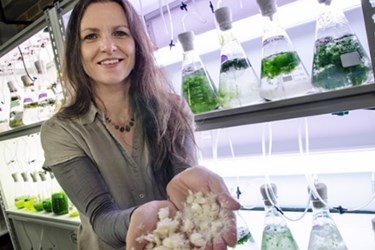Seaweed Could Be Vital Ingredient For 3D Printing BioPen

University of Wollongong researchers are growing jobs and materials from the sea for medical treatments through a project in the Shoalhaven area to farm and process seaweeds that will then be used biomaterials such as cell carriers in medical implants.
Seaweed extracts are already commonly used in goods as diverse as toothpaste, skin care products, paint, ice cream and salad dressing. However, research in the field of glycobiology – the study of complex sugars called glycans in living organisms – is showing that seaweed has a major role to play in the development on new and biologically active materials for medical treatments.
Gel molecules taken from seaweeds are ideal candidates for medical implants and tissue engineering because they provide the necessary structural support and have also been found to act as a frontline defence and communication system in supporting or inhibiting the interaction with microorganisms such as viruses, bacteria and fungi. This would provide researchers with a broader range of biocompatible materials with the ability to fight infectious diseases.
“These gels are highly cell compatible and even stimulate the health and development of human stem cells, so in the instance of looking for new polymer materials for medical implants, seaweeds are a key candidate for the source of such materials,” Dr Winberg said.
The development of seaweed cultivation opportunities for Australia has been considered sporadically in the past decades, but in 2009, a strategic network of researchers and industry people under the umbrella of Seaweeds Australia, hosted at the UOW Shoalhaven Marine & Freshwater Centre in Nowra under the guidance of Dr Pia Winberg, focused on the missing links in making such an industry a reality. Dr Winberg is now continuing this initiative to create a seaweed industry through the start-up operation Venus Shell Systems Pty Ltd.
A recently established collaboration with UOW’s Intelligent Polymer Research Institute (IPRI), the lead node in the Australian Research Council Centre of Excellence for Electromaterials Science (ACES), will delve into how the properties of seaweeds can be harnessed for medical research, particularly in 3D printed implants and for cell compatible materials with bioactive properties. Alginate, an extract from brown seaweeds, has already been used as a cell carrier by IPRI scientists and their partners at St Vincent Hospital Melbourne to aid regrowth of diseased and injured tissue.
 However the opportunities that exist by collaboration with marine scientists will extend the spectrum of biologically compatible, active and printable materials in a big way. Other gels known as ulvans will be extracted from the seaweed farmed at the Shoalhaven site and studied for use as a cell carrier in the recently launched BioPen, which will enable orthopaedic surgeons to deliver live cells and growth factors directly to the site of injury, accelerating the regeneration of functional bone and cartilage.
However the opportunities that exist by collaboration with marine scientists will extend the spectrum of biologically compatible, active and printable materials in a big way. Other gels known as ulvans will be extracted from the seaweed farmed at the Shoalhaven site and studied for use as a cell carrier in the recently launched BioPen, which will enable orthopaedic surgeons to deliver live cells and growth factors directly to the site of injury, accelerating the regeneration of functional bone and cartilage.
Dr Winberg said the unique properties of ulvans could be used in medical treatments such as in the gut for inhibiting enzymes that release sugar and thus slow down metabolic/diabetic stress, in the blood as an anticoagulant or on skin to reduce tumour growth and increase elasticity. Antiviral and anti-inflammatory agents and next-generation anti-bacterial solutions have also been proposed as uses for ulvan gels.
IPRI Director Professor Gordon Wallace said the “ability to tailor the source of biopolymer supply enables highly effective integration into emerging fabrication techniques such as 3D printing and fibre spinning”.
Farming seaweed also provides environmental and economic benefits. Seaweeds strip waste products such as carbon and nitrogen from the ocean and are being used around the world to absorb nutrient inputs from aquaculture and coastal industrial sources. They can also be used to oxygenate water and overcome localised ocean acidification.
“Our seaweed production systems actually strip concentrated CO2 directly from industrial sources – thus increasing the rate of biological carbon uptake and shifting carbon to the biosphere instead of the atmosphere,” Dr Winberg said. “We will also take waste streams of nitrogen from clean industry sources, which would otherwise be lost in the catchment.
“As with all systems introduced by people, you need to have good local management practices. For example we use local species not introduced ones. We need to design systems that look after and improve the local environment. That is the opportunity that seaweed industries in Australia can provide.”
Dr Winberg envisions that Australia can contribute to this global, 18 million tonne biomass industry in a very sophisticated way with a focus on biotech applications.
Source: University of Wollongong
